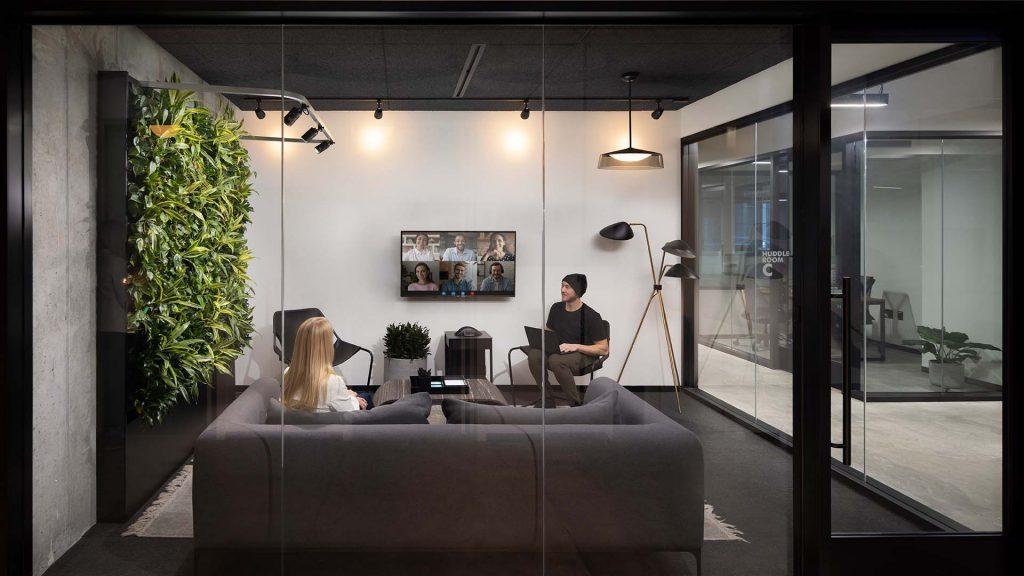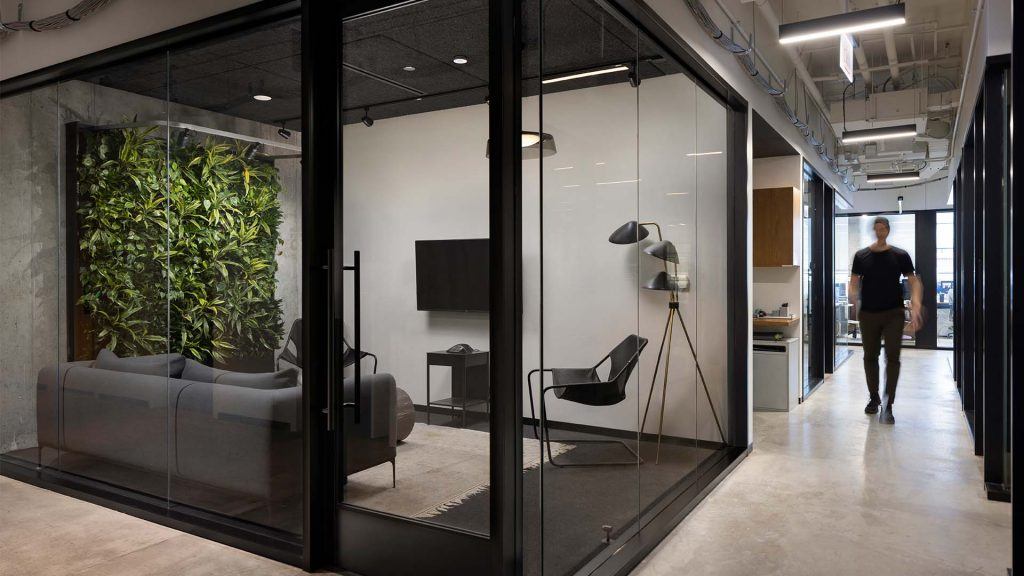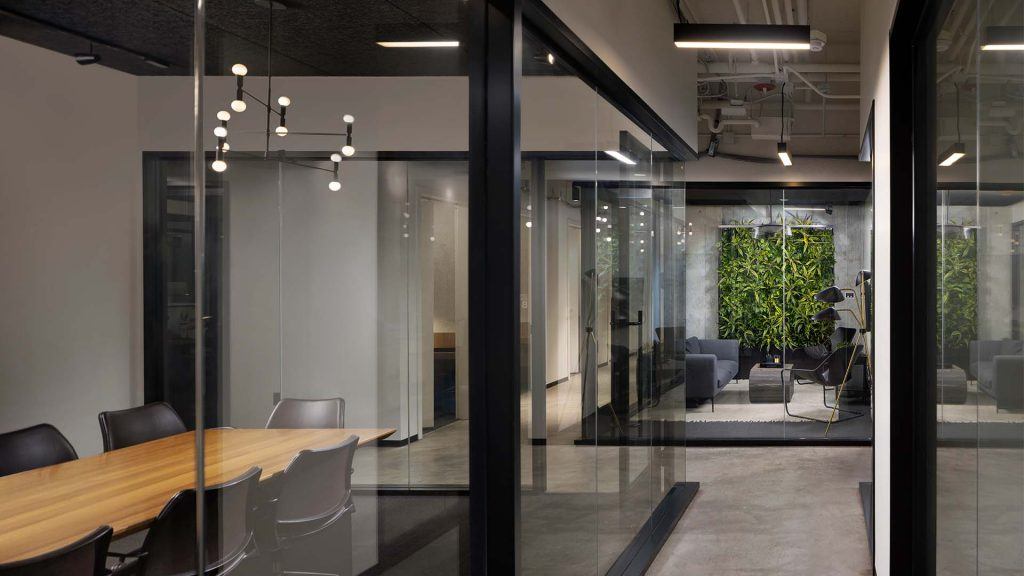Earth Day, April 22, is an opportunity to reflect on everything our planet and environment does for us — we wouldn’t be here without it after all.
Some organizations, however, take it a step further and through a practice called biophilic office design, creatively bring natural elements into the workplace to keep employees connected to the environment and its benefits.
This Earth Day, we wanted to take a moment to highlight the material performance outcomes of biophilic design (a 15% boost in productivity for starters) — as well as spotlight a partnership that allows our members to experience it everyday at Industrious.
 Photo by MILLER + MILLER Architectural Photography
Photo by MILLER + MILLER Architectural Photography
What is biophilic office design?
In a word, it’s a little more thoughtful than simply displaying plants in the workplace (but that’s not a knock against your cherished houseplants).
Biophilic design is a sustainability practice that proposes that since modern humans spend most of their time indoors, we need to reintegrate nature into urban structures to preserve our connection to the environment.
In other words, bringing the outdoors indoors with natural elements like plants, water, and sunlight, as well as materials that similarly evoke our connection to nature (wood and rock, for example).
Biophilic office design, then, is the practice of incorporating these design principles specifically in the workplace.
In the real world, this takes the form of organizations like Google and Etsy experimenting with “design interventions” — and there’s a wide spectrum to what that means. Google, for example, installed new skylights and nature-inspired carpeting in their spaces. Meanwhile Etsy went the extra mile and designed its Brooklyn headquarters to meet the standards of the Living Building Challenge, a rigorous green building certification program.
What this spectrum shows is that while biophilic office design can be a resource intensive endeavor, it doesn’t have to be. By making smart and sensible changes, companies can affordably reap the benefits of biophilic design improvements.
But what are those benefits and why would you want to undertake a biophilic design project in the first place?
Let’s look at the research.
 Photo by MILLER + MILLER Architectural Photography
Photo by MILLER + MILLER Architectural Photography
Why choose biophilic office design?
Now that we’re in the waning days of a pandemic that took a significant toll on, well, everything, organizations are reassessing the way they do things. Two priorities chief on the list? Finding ways to creatively reimagine and reconfigure existing office space freed up the hybrid work model, and exploring new ways to prioritize employees’ mental health.
Biophilic office design is fortunately able to check both of those boxes — and quite a few more.
Productivity, focus, and stress levels all improve when organizations make the effort to thoughtfully incorporate biophilic design elements into their workspaces.
For productivity, a University of Exeter study found employees were 15% more productive when working from spaces that contain plant life. If those offices were green-certified, employees appreciated a 26% boost in cognition, or one’s ability to process information (which also improves productivity).
One thought as to why we see performance gains associated with biophilic office design comes down to something called “Attention Restoration Theory.”
It won’t shock anyone reading this to hear the 8-hour work day is mentally draining and causes employees to experience fatigue and diminished concentration. Attention Restoration Theory proposes that taking time to experience or even just look at natural elements replenishes brain function.
But beyond performance outcomes, biophilic design is a boon for employee wellness too. A University of Exeter research group found that foliage in office settings creates a 47% boost in employee wellbeing. More specifically, plant purified air increases oxygen flow in the body, lowering blood pressure, heart rate, and stress levels.
There are even more benefits too: creativity, air purification, sound absorption. Zauben has compiled research across various studies on this page if you’d like to learn more.
 Photo by MILLER + MILLER Architectural Photography
Photo by MILLER + MILLER Architectural Photography
Biophilic office design at Industrious
The benefits of biophilic design aren’t hypotheticals to be only read about in research papers and blogs. Industrious teamed up with Zauben to bring a biophilic office experience to our Fulton Market location: the Model Z living wall.
“We spend ninety percent of our lives indoors. This lack of exposure to the natural world affects our mood, energy levels, sleep rhythm, physical and mental health—it’s an unhealthy separation,” says Zach Smith CEO at Zauben. “It’s time for a change. The modern office needs to be rethought and redesigned with people and nature in mind.”
The Model Z is a plug-and-play ‘living wall,’ a self-irrigating vertical structure covered in greenery designed to accent indoor spaces. What makes the Model Z special is its innovative IoT sensors, which automate lighting to match plant circadian rhythms and monitor plant health. It’s also designed specifically to adapt to workspaces and can easily be repositioned, whether that’s in different places in an office or a new location entirely.
The Industrious Fulton Market location is the home for Zauben’s first Model Z showroom, where members and guests alike can experience firsthand what a happier, healthier, and greener workplace feels like.
“At Industrious, we’re always looking for new ways to bring our members the best experience possible so we’re thrilled to be hosting Zauben’s Model Z living wall at our Fulton Market site,” said Rachael Gursky SVP of Customer Experience at Industrious.
“We know that now more than ever, employees are looking for their workplace to not only be professionally functional but provide them with the balance of health and happiness that remote work brought.”
If you’d like to book an appointment to visit the Fulton Market Zauben Showroom, you can do so here.